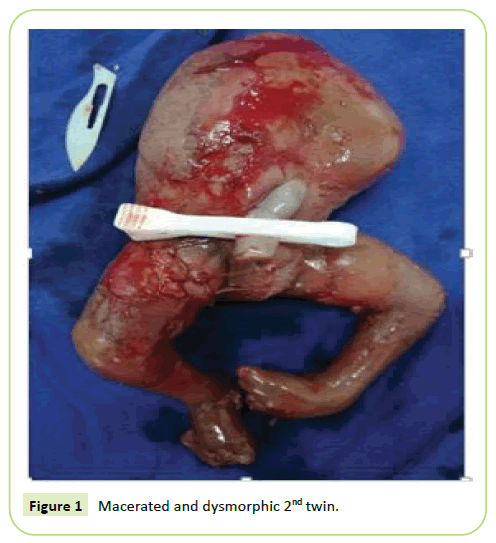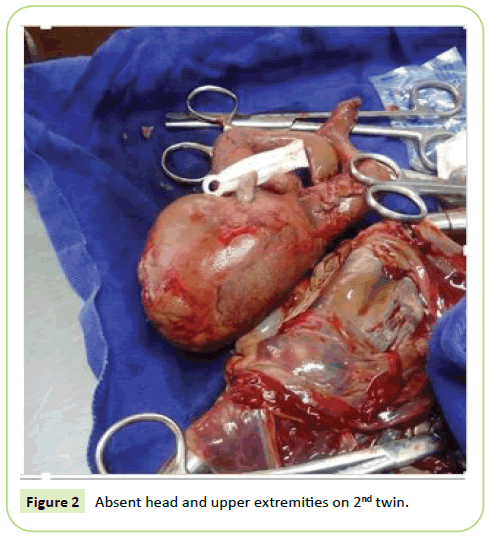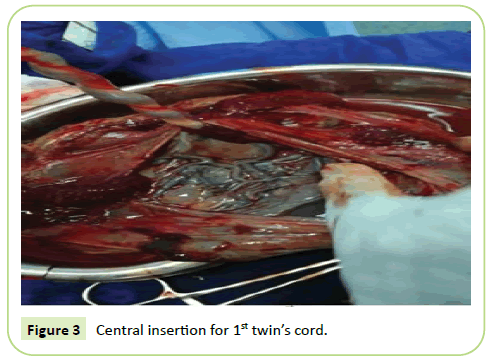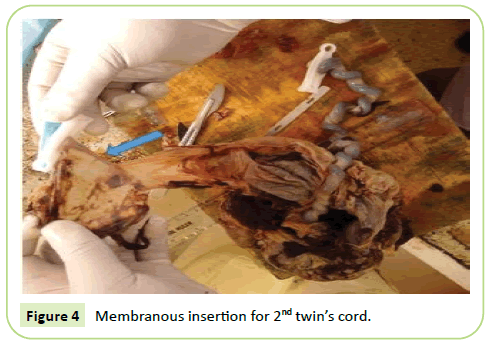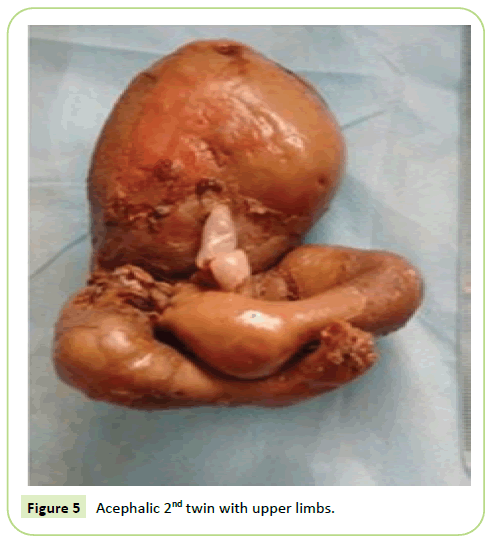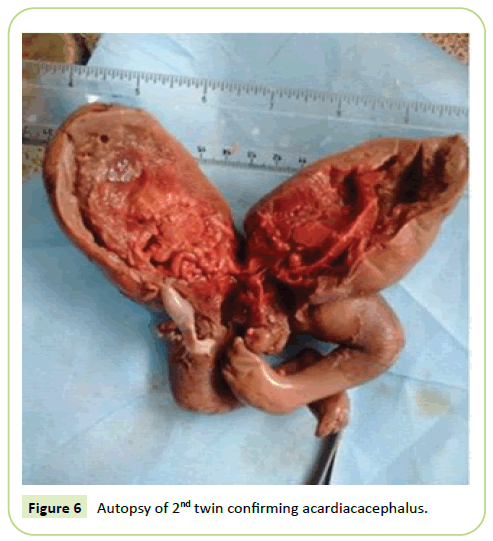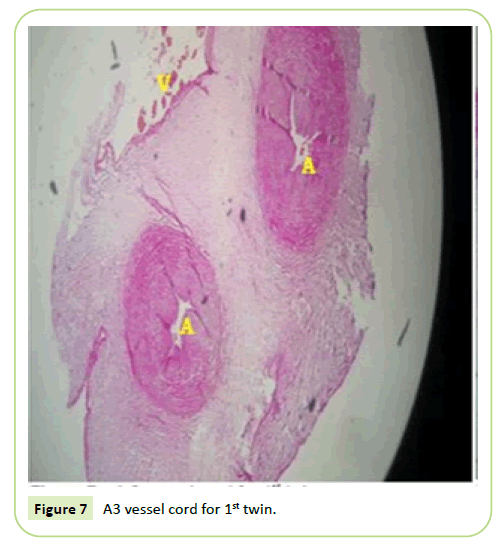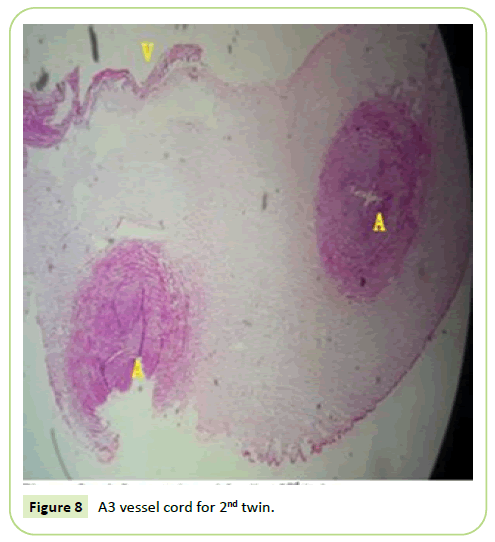Keywords
Acardiacacephalus; Monochorionic twin; Twin reversed arterial
perfusion sequence
Introduction
In twin pregnancies, approximately 20% are monozygotic
and of these, 75% share a placenta. Most monochorionic
twin pregnancies are characterized by varying degrees of
anastomoses. Artery-artery anastomoses predominates in 75%
of monochorionic placentas compared to vein-vein or arteryvein
[1]. Consequently, the presence and persistence of a
hemodynamic imbalance in the two fetal circulations may result
in fetal-fetal transfusion disorders such as the twin reversed
arterial perfusion sequence (TRAPS).
TRAPS or acardiac twinning is arguably the most extreme fetalfetal
transfusion disorder. Essentially, the often normal donor
twin with a heart pumps blood through both fetal circulations.
As such, mortality rate for the donor twin exceeds 50%, more so
without definitive management commonly from heart failure and
prematurity [2]. Historically, the incidence of acardiac twin is about
1 in 35 000 births averaging a 1% risk in monochorionic twins [3].
Van Gemert recently cited an incidence of 2.6% in monochorionic
twins on account of increased assisted reproductive technology
and early cessation of acardiac development [4]. Several
infrequent cases have been reported in West Africa. To our
knowledge no cases of acardiacmonochorionic twin pregnancy with a surviving donor twin have been described in literature in
our setting.
Case Report
A 28-year-old para 0+1 Gravida 2 at 25+6 weeks gestational age
(GA) of a natural conception was admitted from our high risk clinic
(HRC) where she had been on follow-up for chronic hypertension
(HTN) diagnosed at 12 weeks GA with a twin pregnancy in which
one was noted as nonviable and possibly vanishing. Her previous
pregnancy resulted in fetal demise from early onset severe
preeclampsia that she reports to have resolved post-delivery. At
admission, the patient was on methyldopa, had no complaints,
blood pressure (BP) was 118/78 mmHg. Ultrasonography revealed
a twin pregnancy with a single placenta and diamniotic. Twin A
was cephalic, viable, 891g at 26 weeks with polyhydramnios but
no gross anomalies. Twin B in breech with no cardiac activity
had absent head and upper extremities at 23+1 weeks by femur
length. The spine, abdomen and lower limbs were appreciated.
A diagnosis of chronic HTN with a single fetal demise of a grossly
abnormal twin was made.
Upon admission the patient received dexamethasone, continued
with methyldopa for 5 days after which it was stopped due to low BP’s. Her BP remained normal thereafter. Maternal blood
works, urinalysis and echocardiogram were normal. Delivery was
planned for 32-34 weeks GA. Another obstetric scan 15 days later
showed Twin A as viable, cephalic, 1314 g at 29+1 weeks GA,
amniotic fluid index of 24 cm with no gross anomalies. Twin B at
20 weeks was nonviable with absent head, neck and upper limbs.
The abdomen, lower limbs and part of the thorax were visualized.
Color flow Doppler sonography was however not performed.
A week later the possibility of acardiac twin was considered
subject to sonographic confirmation. The patient however went
into spontaneous labour on the same day delivering vaginally a
1300g male 1st twin that scored 6/1, 8/5, 9/10 with no obvious
gross congenital anomalies. He was admitted to new-born
unit (NBU) due to the very low birth weight. The 2nd twin was
breech, macerated, 710 g, with well-developed lower trunk
and extremities but absent head, neck and upper extremities.
Bilateral equino-varus deformity and underdeveloped external
genitalia was also noted (Figures 1 and 2).
Figure 1: Macerated and dysmorphic 2nd twin.
Figure 2: Absent head and upper extremities on 2nd twin.
Grossly, the placenta was single and diamniotic. The first twin’s
cord was of normal length, with a central insertion (Figure 3).
The dysmorphic twin had a short, thin cord with a membranous
insertion (Figure 4).
Figure 3: Central insertion for 1st twin’s cord.
Figure 4: Membranous insertion for 2nd twin’s cord.
After counselling, the patient consented for autopsy on the
suspected Acardiusacephalus and a case write up. Autopsy
confirmed absence of cranium, neck, upper limbs, liver, heart
and spleen. The spinal column was incomplete terminating in the
thoracic region (Figures 5 and 6).
Figure 5: Acephalic 2nd twin with upper limbs.
Figure 6: Autopsy of 2nd twin confirming acardiacacephalus.
Histopathology showed a monochorionicdiamniotic gestation
and both twins had a 3 vessel cord (Figures 7 and 8).
Figure 7: A3 vessel cord for 1st twin.
Figure 8: A3 vessel cord for 2nd twin.
In NBU, the donor twin had a normal cranial ultrasound, a
patent ductusarteriosus (0.2cm) on echocardiogram and had
complications of prematurity that were successfully managed as
per our facility protocol. On day 40 of puerperium, upon weighing
1740g the baby was discharged. Subsequently, the mother and
baby remained healthy.
Discussion
Acardiac twinning is characterized by the presence of a fetus
commonly without a heart with additional absence of other
structures and another often normal pump twin.
It has been postulated that the existence of an artery-artery shunt occasionally accompanied by a vein-vein shunt within a single
shared placenta may result in retrograde flow of deoxygenated
arterial blood from the pump twin to the acardiac twin. Essentially,
perfusion of the acardiac twin’s umbilical circulation, aorta and
vena cava is by reversed flow of deoxygenated blood resulting in
early tissue hypoxia and atrophy of the heart and other organs.
An alternative hypothesis proposes that a severe genetic or other
primary defect sufficient to cause failure of cardiac development
in one of the twins precedes the anastomotic connections and
the reversed flow.
The various varieties of acardiac twin range from the most
developed Acardiusanceps to the least developed Acardius
amorphous. Acardiacacephalus is however the commonest type
where there is no cephalic development and often the upper
extremities and neck are missing too as was seen in this case.
The rare Acardiusacormus and acardiusmyelacephalus have also
been reported [5]. A 3 cord vessel is seen in a third of cases of
acardiac twin with majority of these having abnormal insertions
commonly on the membranes as was seen with this case [5].
Mortality for the acardiac twin is 100%. For the donor twin,
mortality and morbidity occurs in over half the cases due to
heart failure, prematurity and chronic hypoxia from recirculation
of deoxygenated blood via veno-venous anastomosis. Prognosis
may be favourable with a high umbilical artery pulsatility index,
non-rapid growth of the acardiac mass, good cardiovascular
status of the pump twin, large differences in resistive index and a
twin to twin weight ratio less than 50% [6-8].
TRAPS should be suspected on sonography when a grossly
malformed fetus is seen alongside a normal fetus in a
monochorionic twin pregnancy with demonstration of retrograde
blood flow in the dysmorphic twin on color flow doppler.
Recurrence has not been documented and no maternal risk
factor has overtly been associated with acardiac twinning.
Over half of cases with TRAPS diagnosed in first trimester may
have spontaneous cessation of blood flow to the acardiac twin
before 16-18 weeks or later [9,10]. We believe this was so for our
case. Therefore, conservative management with serial weekly
sonographic surveillance is not unreasonable in select cases of a
normal donor twin with favourable aforementioned prognostic
indicators and limited resources for interventions.
This spontaneous cessation of blood flow may however result in
subsequent death or neurological injury of the normal twin in
over 60% of cases [9,10].
Pagani et al. found a reduction in adverse pregnancy outcomes
when intervention was done preferably before 16 weeks
compared with at or after 16 weeks or with conservative
management [11]. Consequently some have advocated for prophylactic intervention rather than expectant management
preferably at about 16 weeks [8,11]. Conversely, a metaanalysis of
pregnancies treated at 12-27 weeks, found an inverse association
between GA at treatment and GA at birth [10].
The ongoing “TRAPIST” trial (TRAP Intervention STudy), a multicentre
open-label randomized controlled trial to assess if early
intervention (12.0-14.0 weeks) improves the outcome of TRAPS
as compared to late intervention (16-18 weeks) is set to clarify
this uncertainty.
For treatment, prenatal interruption of blood flow to the acardiac
twin via intrafetal ablation techniques under ultrasound guidance
is widely used and recommended as it is associated with a higher
rate of clinical success and favourable outcomes than cord
occlusion techniques [8,11]. Specifically, radiofrequency ablation
or laser ablation of the acardiac twin’s intraabdominal vessels
may be used since either intrafetalmethods have comparable
survival rate of over 80% for the donor twin [9-11]. Preterm
rupture of membranes remains the commonest post procedural
complication.
More recently, the non-invasive High Intensity Focused
Ultrasound (HIFU) has also been successfully used [12,13].
Historically, maternal digoxin and indomethacin have also been
used. Despite their limited role in modern practice, these may be
considered in carefully selected patients who wish to keep their
pregnancy in the setting of limited interventional resources or
expertise.
Conclusion
Ultimately, studies involving follow-up of the surviving donor
twins are needed to objectively inform on possible adverse
long term outcom.es, if any, of intervention or lack thereof on
the donor twin. As a unique and extreme complication, TRAPS
necessitates a thorough clinical and sonographic evaluation as
well as high index of suspicion in mono-chorionic multi-fetal
pregnancies.
Conflict of Interest
The authors declare that there are no conflicts of interest.
Acknowldgement
Sincerest appreciation to Dr. MosheyIssa, Dr. Mruttu Caroline,
Dr. Li Ping and the Department of Reproductive Health, Moi
University for their immense support. This case was accepted for
an e-poster abstract presentation at the XXII FIGO World Congress
2018 and an earlier version of the abstract was published in
the International Journal of Gynaecology and Obstetrics. (DOI:
10.1002/ijgo.12583).
References
- Cunningham FG, Leveno KJ, Bloom SL, Spong CY, Dashe JS, et al. (2014) Multifetal pregnancy. In: Williams Obstetrics. 24th Edition. McGraw-Hill Education, UK. pp. 891-924.
- Moore TR, Gale S, Benirschke K (1990) Perinatal outcome of forty-nine pregnancies complicated by acardiac twinning. Am J Obstet Gynecol 163 (3): 907-912.
- Gilim DL, Hendricks CH (1953) Holoacardius; review of the literature and case report. Obstet Gynecol 2 (6): 647-653.
- Van Gemert M, Van den Wijngaard J, Vandenbussche F (2015) Twin reversed arterial perfusion sequence is more common than generally accepted. Birth Defects Research Part A: Clinical and Molecular Teratology 103: 641-643.
- Roberto Ruiz-Cordero, Rhea JB, Liset P, Michel A, Maria MR (2016) Twin Reversed Arterial Perfusion Sequence (TRAPS): An Illustrative Series of 13 Cases. Fetal and Pediatric Pathology 35: 2: 63-80.
- Brassard M, Fouron JC, Leduc L, Grignon A, Proulx F (1999) Prognostic markers in twin pregnancies with an acardiacfetus. Obstet Gynecol 94 (3): 409-414.
- Dashe JS, Fernandez CO, Twickler DM (2001) Utility of Doppler velocimetry in predicting outcome in twin reversed-arterial perfusion sequence. Am J Obstet Gynecol 185 (1): 135-139.
- Mone F, Devaseelan P, Ong S (2015) Intervention versus a conservative approach in the management of TRAP sequence: a systematic review. J Perin Med 44 (6): 619-629.
- Lewi L, Valencia C, Gonzalez E (2010) The outcome of twin reversed arterial perfusion sequence diagnosed in the first trimester. Am J Obstet Gynecol 203: 213. e1-4.
- Chaveeva P, Poon LC, Sotiriadis A, Kosinski P, Nicolaides KH (2014) Optimal method and timing of intrauterine intervention in twin reversed arterial perfusion sequence: Case study and meta-analysis. Fetal Diagn Ther 35 (4): 267-279.
- Tan T, Sepulveda W (2003) Acardiac twin: A systematic review of minimally invasive treatment modalities. Ultrasound Obstet Gynecol 22: 409-419.
- Okai T, Ichizuka K, Hasegawa J (2013) First successful case of non-invasive in-utero treatment of twin reversed arterial perfusion sequence by high-intensity focused ultrasound. Ultrasound Obstet Gynecol 42: 112-114.
- Ichizuka K, Hasegawa J, Nakamura M (2012) High-intensity focused ultrasound treatment for twin reversed arterial perfusion sequence. Ultrasound Obstet Gynecol 40: 476-478.

